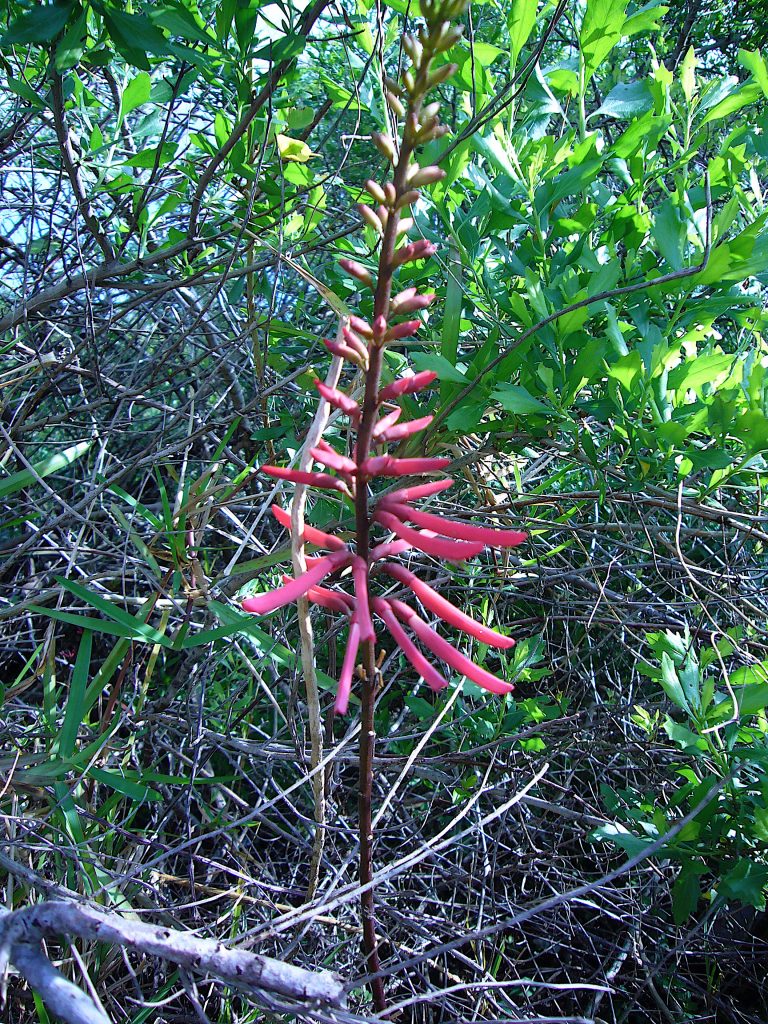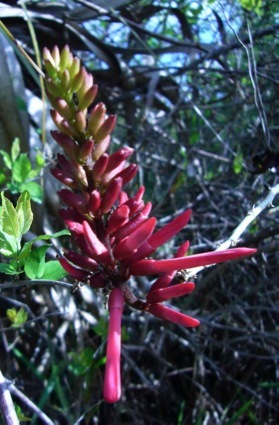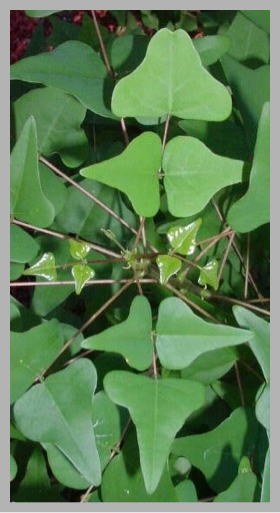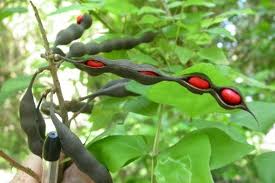
The Eastern Coral Bean is easy to spot this time of year. Photo by Green Deane
Erythrina herbacea: Part Edible, Part Not
The (eastern) Coral Bean is one of those damned if you do, and damned if you don’t kind of species. Parts of it are edible, parts of it are toxic, narcotic and hallucinogenic. So there is a trade off: Very easy to identify, but harvest carefully.
The boiled flowers and young leaves are edible, cooked like string beans but in more water. This semi-toxic plant is also quite healthy. A Japanese study published in the Journal of Natural Medicines, 29 Jan 2008, confirmed five antioxidants in the coral bean flower and found a sixth antioxidant. I boil mine for 15 minutes in plenty of water. They turn green and limp when cooked and reduce in size so collect a lot. The flavor is mild, like young spinach.
Coral Bean is a plant of the old South and into Mexico. But, it can grow not only across the southern tier of the United States but up the east coast to Maryland and up the west coast to Washington state. Out hiking it is always very easy to spot though in the wild it is rarely more than a spindly bush. However most people know the coral bean as a landscape plant and under cultivation and ideal conditions can reach 25 feet.
It is one of those odd thing in the plant world that people interested in plants tend to view them three basic ways. One is the agriculturist who views them as a commodity. There are those like foragers who tend to land on the nature side of things. They want to know where does it grow and can it be eaten. Then there are those who view plants like artistic elements to be put in a living canvas, the landscaped garden. I have a close friend like that. His property is as disciplined as mine is feral. He knows probably not a botanical name, nor which leaf he can eat, yet he’s a good husband of his plants and his yard a thing of beauty. He works very hard at it.
A coal bean to him would be a bit of color, and color over time because a landscaped garden is an interplay of plants as the season progresses. To an agriculturist the coral bean is a source of costly contamination, especially the seeds. It is a weed, weeds cost money and they are thus called noxious and must be dealt with as some enemy. To me it is something to add to the herb pot if it is shy on content. And I suppose there is a fourth group that includes most people. They ignore plants even though their lives depend on them.
The coral bean is an interesting plant for many reasons, one of which is that it always turns it leaves towards the sun. Each petiole has three uterine-shaped leaves, two on short stems but all three stems have the ability to turn the leaf. And you will notice unlike most trees and more like an herb, the smaller leaves are in the middle. Those are the edible young leaves, and of course, the red blossoms, both cooked. The seeds are NOT edible. They have been used for beads, however, and played an important religious role for the Aztecs in auguring the future. In tiny amounts the seeds are said to be hallucinogenic.
As for the toxin, it is not great according to the data base of the state of North Carolina. It varies from according to age, weight, physical condition and individual susceptibility. Most of the reports involve kids eating the scarlet seeds. In Mexico the seeds are used to poison rats, dogs and fish. It is similar to curare and hypnotic. That the flowers and leaves are edible is confirmed by no less august authority than Dr. Julia Morton, who for most of her life was the final say on toxic plants in warm climates, such as Florida. In fact, she is one of the experts that authored the edible plant portion of the U.S. military’s survival guide. I like the flowers. Boiled they are a mild in flavor.
The flowers of the Erythrina flabelliformis (fla-bel-ih-FOR-miss, fan shaped) are reported as edible — very favored in Mexico — but I have not tried them.
As for the botanical name of the coral bean, Erythrina herbacea (air-rith-RYE-nuh hur-BAY-see-uh) …There are about 112 species in the genus Erythrina, which comes from the Greek word ερυθρος which means red. The species name, herbacea in Latin means “grass, low growing, not woody.” It was named that because this particular plant is more herbaceous than others in the genus. Many of the plants in the genus are well-known and used in the tropics and subtropics as street and park trees. Some are used as shade trees for coffee or cacao and can grow to a hundred feet high. In most of its range in the United State the Coral Bean is a bush. The common name might come from the fact the flowers are shaped like a form of red coral. It is also called the Cherokee Bean, who used a decoction of the root for various purposes including kidney and urinary blockage.
Besides brilliant color the Coral Bean’s second claim to fame is that it’s fast food for humming birds. They were made for each other and one of the quickest way to get hummers to your yard is to grow a Coral Bean, just keep the seeds away from the kids. Humming birds, by the way, follow routes, kind of like air corridors called traplinings, (for next time you’re playing scrabble….
Other known edibles in the genus include E. americana, E. berteroana, E. fusca, E. rubrinervia, and E. veriegata.
Green Deane’s “Itemized” Plant Profile
IDENTIFICATION: Bush, three to sixteen feet,compound, uterine-shaped leaves lost in winter in cooler areas, kept in warm areas, herbaceous, bushy, can survive a lot of trimming. Stems have small, curves prickles, as do leaves. Flowers on leafless spikes in early to early summer depending upon the latitude, young leaves throughout the growing season. Easily blooms in February in Florida. Occasionally blossoms in fall. In dry areas can keep blossoms after leaves have fallen
TIME OF YEAR: Broken shade, sandy woods, hardwood hammocks, dry coastal tidewater areas, roadsides
ENVIRONMENT: Usually an understory plant among other bushes. But I’ve also seen it grow in full sun. Become less common due to destruction of habitat.
METHOD OF PREPARATION: Boil young leaves and blossoms in ample water. Whether the blossoms are edible raw is a bit of a debate with one authority quoting another in a questionable reference saying yes. Be safe and don’t eat them raw. I know one can be eaten raw but beyound that I do know know. Besides containing harmful alkaloids, they contain antioxidants. Flowers turn mushy while cooking and loose their red color.




